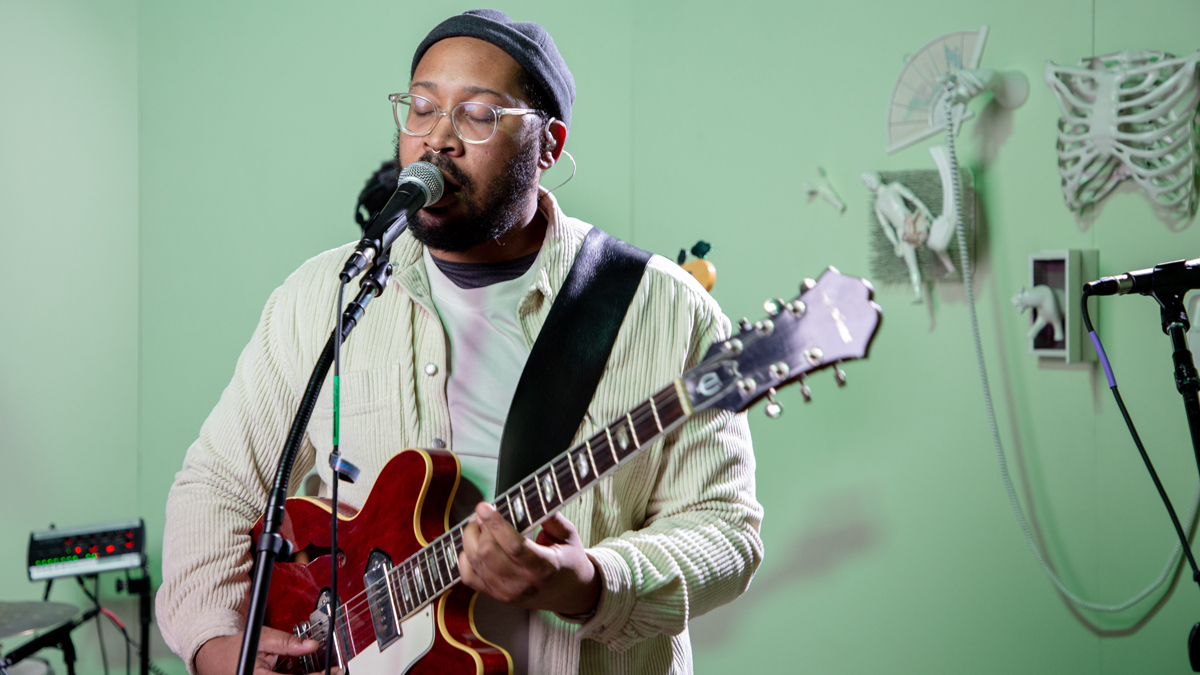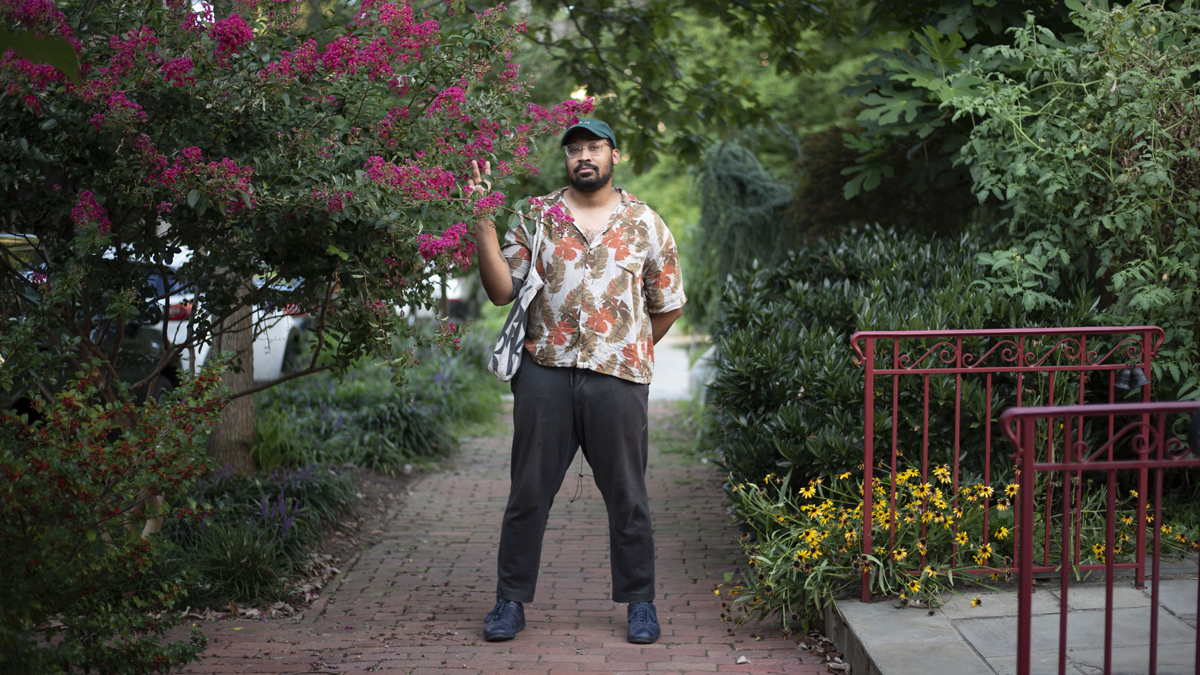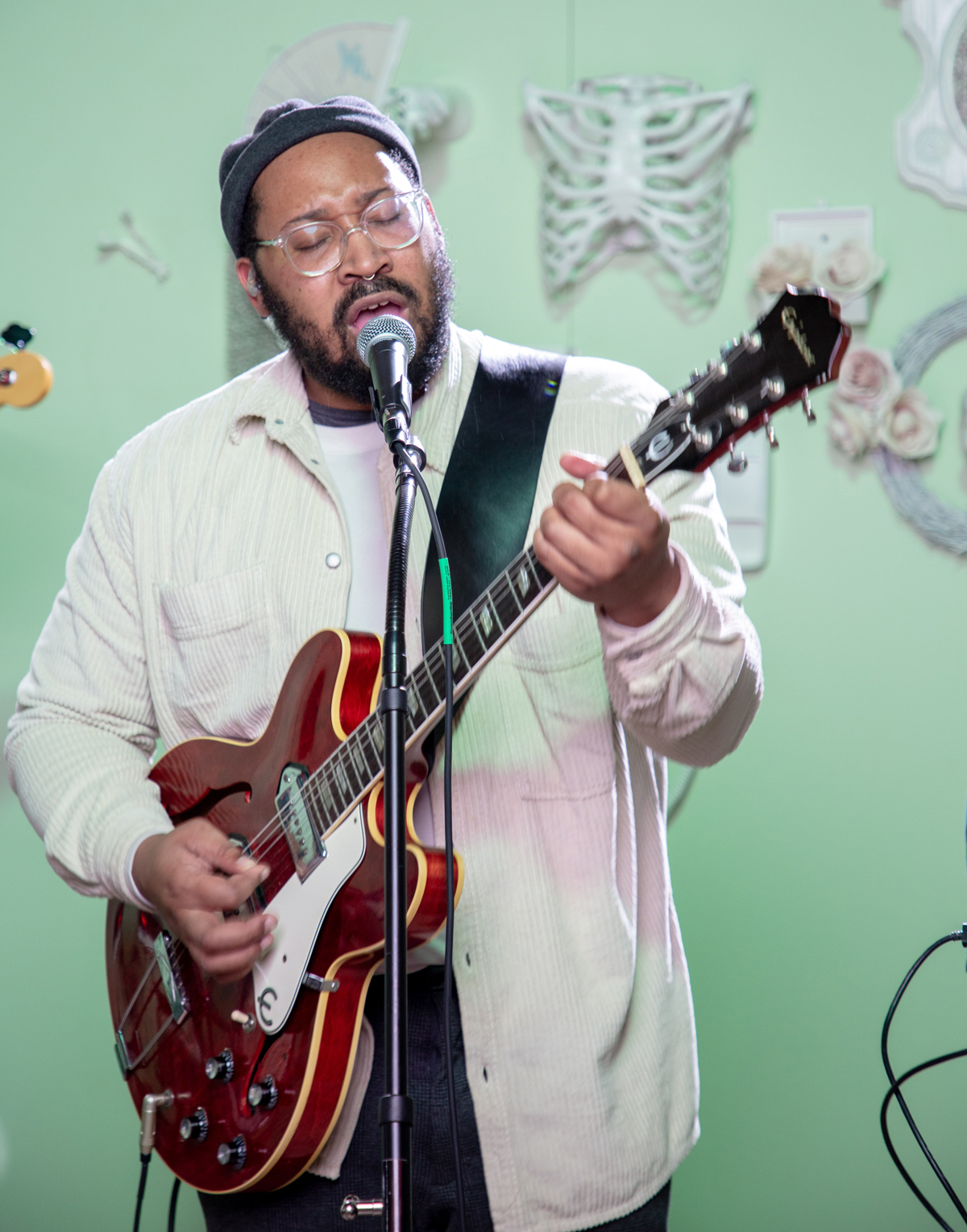Bartees Strange: "I'm very into showing that things from different genres work really well within each other"
Strange smashed hardcore, hip-hop and jazz into one of 2020's boldest albums. Here, he dishes on gear collecting, breaking boundaries, and how TV on the Radio and At the Drive-In changed his life

If you’ve seen the video for Boomer, one of the singles from last year’s Live Forever debut by Bartees Strange, you may have spotted the D.C.-based musician blurring the boundaries of genre as a one-man band.
The song itself journeys through flavors of post-punk, hip-hop, blues and soul in a way that feels excitingly cohesive, both unpredictable and familiar at the same time. By the singer-songwriter’s own admission, it was one of the most challenging tracks to write for his first solo album...
“That one was an adventure,” he tells GW, from his home studio. “I was really intimidated by that song when I finished it. I didn’t think anyone would like Boomer, because it does so many things. But to me it made sense and felt great. I’ve always wanted to hear a song like that.
“The guitars ended up being very simple – a Stratocaster into a Vibro Champ turned all the way up, completely cranked. It’s like the Led Zeppelin trick, big sounds through smaller gear, big drums but fewer mics...
“Sometimes if you want things to sound bigger you have to use less, and this song is a great example of that. As for the structure, I was really influenced by a lot of hip-hop I was hearing.
“Starting the song with lyrics on the one is like, ‘Boom, we’re in!’ It’s a big hip-hop move that Lil Baby does a lot. I wanted to do it in more of a rock context. I’m very into showing [that] things from different genres work really well within each other… this song was a big opportunity to do that and I tried to take it as far as I could.”
It’s not the only track on the debut that strings together interesting sounds in an unusual way – if anything, that sense of ethereal wanderlust runs over the course of its 11 songs, at times threading through sonic pastures few would dare to connect. In A Cab, for example, reimagines grunge with the kind of horns you’d expect to hear on a James Bond soundtrack. It’s both bold in ambition and flawless in execution…
Get The Pick Newsletter
All the latest guitar news, interviews, lessons, reviews, deals and more, direct to your inbox!
“It came out pretty wild,” laughs Strange. “I remember writing the demo for that song and it was a much slower and less jazzy version. When we started tracking it, I was trying to find the right balance between hip-hop drums, jazz guitars and controlled insanity. I was literally thinking about this ball that keeps rolling and rolling, picking up more and more things but it still remains contained and within the frame.
“I think we mixed In A Cab about 20 times to find the right balance. Even though it’s very simple guitar-wise, with just a few jazz chords, it became one of my favorite songs on the record. I think it ended up being mainly a Telecaster through an AC15 with an SM7B right on the cone. The other amp was a ‘71 Vibrolux with a ‘66 Jaguar, with a U87 in the room, so just letting it rip. There was one soft tone and one heavy tone, so we just blended the two.”
The next track on the album, Stone Meadows, almost has flickers of Radiohead to it...
“Wow, you saying that is some life-affirming shit. The reference track for it was 2 + 2 = 5, especially verse one where it’s just mainly drums and bass. The guitar I used was one of my favorites: a ‘67 Epiphone Casino. I was tracking it through my Vibrolux with a Source Audio Ventris Dual Reverb.
“That’s kinda become my main reverb. I use it as a studio tool as well, it’s amazing. So pretty much all the reverbs came from the lo-fi setting on that Ventris, in conjunction with other things like my 1981 Inventions DRV Overdrive.”
What else did you have on the ‘board?
“I also used an Echoplex and Space Echo a lot. I collect a lot of old stuff – I’m a bit of a gear person. I like to accumulate tape machines, that’s part of my thing! [laughs] The guitars are going through a lot of different processing, depending on the song. Some might just need an Echoplex right into the amp, others might need all the guitars through a Space Echo just to make it sound really cool.
I write everything on guitar, but it doesn’t always have to come out that way. I want to write the best song possible
“For Stone Meadows, I definitely ran all the chorus parts through the Space Echo, which is why it sounds like this big, compressed chunky wall. As for the rest of my pedalboard, I used a Chase Bliss Warped Vinyl on a bunch of stuff. I also have this Jackson Audio Broken Arrow multi-gain stage drives, plus the 1981.
“I really like to crank amps for the overdrive, though… and I’m a sucker for Fender amps. I’ve got vintage Vibro Champs and Vibroluxes, tweeds and Bassmans. I just love how they sound. Then I have a couple of Vox amps, too.”
Your choice of instrumentation is also very interesting because – let’s face it – guitar players can often be very guitar-centric!
“I mean, I write everything on guitar, but it doesn’t always have to come out that way. I want to write the best song possible. If a guitar gets dropped, that’s okay. I’m a big collaborator. I really trust my band and when we’re recording, we’ll try something and open it up, and try a million other things. I’m always open when it comes to that side of it.
“I don’t think there’s a secret when it comes to my tone. I don’t like too much going on, other than a good overdrive and loud amp. Songwriting is really where I spend most of my time. I recorded it pretty much myself. Me and my buddy Brian [DiMeglio] brought all our gear up to a barn, got our ears blown off and had a good time. We’re all pretty good engineers.”

You were born in England and spent time in Germany and Greenland before your family eventually moved to Oklahoma. Could that be connected to the sense of travel in your music?
“Totally. I really think the reason why a lot of my music sounds the way it does is because I have friends all around the world. And when they share their music with me, I’m hearing their part of the world. Even when I moved to the States, eventually I got AOL Instant Messenger and was able to reconnect with friends in Ipswich. By that time, they were into Burial… and I’d never heard of Burial.
Growing up and learning how to play, everyone around me was into country… I would go to the guitar shop and watch those guys play and go home trying to copy as much as I could
“That was a life-changing moment. A friend told me to look up his Untrue album with the song Archangel. It totally shook my little world. Then I got into Bloc Party, Klaxons stuff like Golden Skans… all of those British artists really hit me. Songs like Flagey God and Ghostly, as well as some of the newer stuff I’m making now, point back to that community of friends all over the world, including people I’d met at various air force bases.”
And as for Oklahoma, there certainly must have been a lot of music around during your years growing up there...
“Oklahoma has a rich musical history, especially for country, bluegrass and Americana. There were also some pretty spectacular funk bands in the '70s, like The Gap Band, plus other great players like Garth Brooks. There are tons and tons.
“I actually grew up on Garth Brooks Boulevard, not far from where Garth’s mom lived. There was a local guitar shop called CBR Guitars, run by this dude called Dale. He was a big guitar player from all these big country acts in the '80s, he’s an exceptional clawhammer fingerpicking guitarist.
“Growing up and learning how to play, everyone around me was into country. There were a lot of fingerstyle players. I would go to the guitar shop and watch those guys play and go home trying to copy as much as I could. That was my intro to guitar, I never really had lessons or learned music theory or how to read music.”
So it’s been more from a ‘school of life’ standpoint than anything too structured…
“Yeah, I got pretty good with just my ears and being able to pick licks off – if I hear something, I can keep it in my head and try to learn it in different ways or keys, or find more scales of those licks. I’d sing the next note in order to find it.
“Those country dudes taught me a lot of tricks and turnarounds, so the guitar came to me very naturally. It just worked. I use my hands a lot, and don’t really use picks unless I have to, which is pretty rare.”
Then, of course, there’s the more bluesy and punk rock side to your music – you played in a hardcore band [Stay Inside] for a while…
“Yeah, I was really into hardcore bands as a kid. I remember the first time I heard F.C.P.R.E.M.I.X. by The Fall Of Troy. Hearing Thomas Erak was pretty inspiring. The dude is super-fast and very musical, and he was singing the whole time. They were a trio that sounded like a five-piece. It was so melodic and dynamic. He was a big hero of mine.
“I also loved players like Albert Collins, Albert King and Stevie Ray Vaughan. I’m a big Peter Frampton fan, too. Those guys introduced me to a lot of ideas I use in my own music... you were talking about the end of Boomer, and that’s just some bat-country blues shit! The kind of stuff my grandfather would play outside on his porch.
“Other players I liked were The Brothers Johnson and the players from The Isley Brothers. I was always fascinated by Parliament and how they used guitars in different ways, unconventional at points. I guess that’s why I liked Peter Frampton doing that talk box thing – it felt really wild when I first heard it.”

Can you remember the moment you decided to pick up the guitar?
“My mom is a singer and was always trying to get me to play piano, trumpet or cello… I was so bad at all those instruments. I really sucked. In seventh grade, I played trumpet in a band and flunked out. I got an F and was the only kid to fail. It made me feel like I wasn’t a good musician.
I’d never seen anyone that looked like me playing guitars in a way that I wanted to play. I didn’t want to be a blues player
“Then I was watching television and saw TV on the Radio playing. I saw them and thought, ‘That’s who I want to be, I want to do that!’ That performance really changed what I thought a guitar could do. And then I saw At the Drive-In play early on and watched Omar Rodríguez-López in a crowded room full of white kids in Oklahoma City. This band walked in from El Paso, Texas, with this big-ass hair and they were all talking Spanish.”
That must have felt pretty damn inspiring!
“I was like, ‘Whoa, this is the coolest thing in the world!’ I was the only person of color in the whole room. I saw them do One Armed Scissor and saw a future in what Omar was doing on guitar. I wanted to be like them.
“I’d never seen anyone that looked like me playing guitars in a way that I wanted to play. I didn’t want to be a blues player. Growing up, everyone used to tell me I must love Jimi Hendrix and I’d be like, ‘I guess, man, I like him but don’t want to play like him.’
“So seeing ATDI really changed my life and I’m forever grateful for those experiences. Everything I do today is because of those two bands.”
Amit has been writing for titles like Total Guitar, MusicRadar and Guitar World for over a decade and counts Richie Kotzen, Guthrie Govan and Jeff Beck among his primary influences as a guitar player. He's worked for magazines like Kerrang!, Metal Hammer, Classic Rock, Prog, Record Collector, Planet Rock, Rhythm and Bass Player, as well as newspapers like Metro and The Independent, interviewing everyone from Ozzy Osbourne and Lemmy to Slash and Jimmy Page, and once even traded solos with a member of Slayer on a track released internationally. As a session guitarist, he's played alongside members of Judas Priest and Uriah Heep in London ensemble Metalworks, as well as handled lead guitars for legends like Glen Matlock (Sex Pistols, The Faces) and Stu Hamm (Steve Vai, Joe Satriani, G3).
“I met Joe when he was 12. He picked up a vintage guitar in one store and they told him to leave. But someone said, ‘This guy called Norm will let you play his stuff’”: The unlikely rise of Norman’s Rare Guitars and the birth of the vintage guitar market
“This would make for the perfect first guitar for any style of player whether they’re trying to imitate John Mayer or John Petrucci”: Mooer MSC10 Pro review




![John Mayer and Bob Weir [left] of Dead & Company photographed against a grey background. Mayer wears a blue overshirt and has his signature Silver Sky on his shoulder. Weir wears grey and a bolo tie.](https://cdn.mos.cms.futurecdn.net/C6niSAybzVCHoYcpJ8ZZgE.jpg)

![A black-and-white action shot of Sergeant Thunderhoof perform live: [from left] Mark Sayer, Dan Flitcroft, Jim Camp and Josh Gallop](https://cdn.mos.cms.futurecdn.net/am3UhJbsxAE239XRRZ8zC8.jpg)




